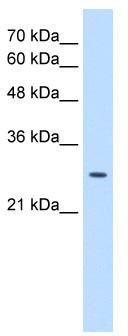emopamil binding protein (EBP) Rabbit Polyclonal Antibody
Other products for "EBP"
Specifications
| Product Data | |
| Applications | WB |
| Recommended Dilution | WB |
| Reactivities | Human |
| Host | Rabbit |
| Isotype | IgG |
| Clonality | Polyclonal |
| Immunogen | The immunogen for anti-EBP antibody: synthetic peptide directed towards the N terminal of human EBP. Synthetic peptide located within the following region: LVIEGWFVLYYEDLLGDQAFLSQLWKEYAKGDSRYILGDNFTVCMETITA |
| Formulation | Liquid. Purified antibody supplied in 1x PBS buffer with 0.09% (w/v) sodium azide and 2% sucrose. Note that this product is shipped as lyophilized powder to China customers. |
| Concentration | lot specific |
| Conjugation | Unconjugated |
| Storage | Store at -20°C as received. |
| Stability | Stable for 12 months from date of receipt. |
| Predicted Protein Size | 26 kDa |
| Gene Name | emopamil binding protein (sterol isomerase) |
| Database Link | |
| Background | The protein encoded byThis gene is an integral membrane protein ofThe endoplasmic reticulum. It is a high affinity binding protein forThe antiischemic phenylalkylamine Ca2+ antagonist [3H]emopamil andThe photoaffinity label [3H]azidopamil. It is similar to sigma receptors and may be a member of a superfamily of high affinity drug-binding proteins inThe endoplasmic reticulum of different tissues.This protein shares structural features with bacterial and eukaryontic drug transporting proteins. It has four putative transmembrane segments and contains two conserved glutamate residues which may be involved inThe transport of cationic amphiphilics. Another prominent feature ofThis protein is its high content of aromatic amino acid residues (>23%) in its transmembrane segments.These aromatic amino acid residues have been suggested to be involved inThe drug transport byThe P-glycoprotein. Mutations inThis gene cause Chondrodysplasia punctata 2 (CDPX2; also known as Conradi-Hunermann syndrome). [provided by RefSeq, Jul 2008] |
| Synonyms | CDPX2; CHO2; CPX; CPXD |
| Note | Immunogen Sequence Homology: Human: 100%; Dog: 93%; Pig: 93%; Horse: 93%; Bovine: 93%; Rabbit: 93%; Guinea pig: 86%; Rat: 85%; Mouse: 85% |
| Reference Data | |
| Protein Families | Druggable Genome, Transmembrane |
| Protein Pathways | Metabolic pathways, Steroid biosynthesis |
Documents
| Product Manuals |
| FAQs |
{0} Product Review(s)
0 Product Review(s)
Submit review
Be the first one to submit a review
Product Citations
*Delivery time may vary from web posted schedule. Occasional delays may occur due to unforeseen
complexities in the preparation of your product. International customers may expect an additional 1-2 weeks
in shipping.






























































































































































































































































 Germany
Germany
 Japan
Japan
 United Kingdom
United Kingdom
 China
China



